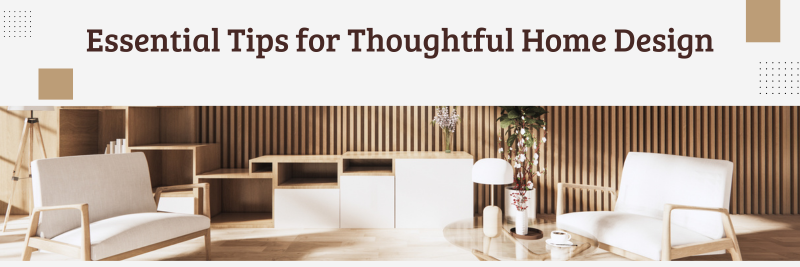Introduction
Home designing is not just about picking furniture and the colors of paint; it is more about designing a space that reflects your personality and meets all of your needs, so it feels welcoming both to you and your guests. Designing an effectively harmonious home will enhance the mood, functionality, and flow in the space. Whether you are moving to a new home or just looking to renew your current space, this often calls for considering several aspects that define a well-balanced design. This guide shares practical tips and insights on understanding space, choosing colors, placing furniture, and other effective elements in creating a balanced yet beautiful home.
1. Understanding Your Space
- A very thoughtful home design starts with having an in-depth understanding of space. This includes measurements of room dimensions, noting architectural features, and the flow of natural light.
- Think about how people will use the different rooms and how they’ll move through space. The right layout also takes furniture placement, doorways, and windows into account.
- Pay particular attention to the focal points of the room, be it large windows or a fireplace, and design around these elements.
2. Choosing a Cohesive Color Palette
- Therefore, the atmosphere of a room is always set by the colors that you choose. Warm tones are from reddish to yellowish as well as to orange while cool tones give a soothing touch like whites and pale greens, blues, and even taupes.
- A minimum of a palette and its variations would be fine for a harmonious look, with consistency and flow from one room to another.
- Neutral colors with accent pieces like throw pillows, rugs, and artwork create contrast for flexibility over time to adapt the feel of the room.
3. Furniture Placement & Proportion
- Placement of furniture in an apartment serves to create a functional and comfortable living space. Be sure to incorporate pieces that both sustain comfort while making no sacrifices when it comes to the style. The selection should work well in all the dimensions of the room.
- Balance is the key; therefore, large furniture should be in proportion with a small number of smaller pieces to ensure a balance. Think of that really big section sofa when it’s accompanied by a little side table never allowing the whole room to get so crowded.
- Think of traffic flow, how people are going to navigate the space. There needs to be enough open area around furniture so that you don’t feel squished and that’s creating openness.
4. Lighting Choices
- Lighting is an integral component of home design and will effect both how a space functions and how that space feels. Use a combination of daylight and artificial lighting to warm up a space.
- Layering light is very important; use ambient lighting, such as ceiling fixtures, task lighting, like reading lamps, and accent lighting, which will draw attention to artwork or architectural features.
- Consider the color temperature of light bulbs; warmer lights are great for living spaces, whereas cooler lights can be used in the kitchen or study where focus is required.
5. Incorporating Personal Style
- A house is meant to mirror the personality and lifestyle of its owner. Sincerely incorporate personal characteristics such as art, family mementos or travel tokens into the design.
- Balance needs to be obtained-there are far too many personal items that can take over a space, so use elements of them wisely. Like, a gallery wall can display your favorite pieces without being cluttered.
- Integrate old and new by combining modern furniture with vintage accessories or heritage styles. Depth is then brought to the design, and a unique, layered look is achieved.
6. Storage Solutions & Organization
- It is a stress-free home when it is organized. Thoughtful storage solutions will keep the environment tidy, something that is very important in small spaces.
- Built-in storage units such as shelves and cabinets can make extensive use of a lot of vertical space, but multifunctional furniture with hidden storage is perfect for small rooms.
- The most frequently accessed items should be kept within the household’s reach. Items that are seasonal and not frequently used will be kept hidden. This reduces visual clutter and makes daily living more efficient.
7. Sustainability & Long-term Design
- Sustainable home designs help to make an eco-friendly home-staying fashionable and functional for years to come. Choose materials with an excellent life span and also low impact on the environment.
- Invest in quality pieces that won’t become outdated in a few years. Classic designs ensure you won’t need to change your furniture or dérive from your house again and again.
- Use energy-efficient lighting and appliances, and use natural materials like wood, stone, and bamboo. This reduces the carbon footprint of your home and makes the indoor environment healthier.
Conclusion
A well-thought-out house making process is very fulfilling, as it offers functionality as well as aesthetics. Therefore, if you understand your space, make the right color selection, and select the furniture accordingly, you can come up with a comfortable and stylish home. This integration of personal elements ensures that your space is a reflection of who you are. Careful consideration of storage and sustainability prevents your home or office from looking messy or causing pollution. For upgrading your home design, there are some brands, such as ABM Furnitures- the best furniture showroom in Indore. Here, we can get a large variety of customizable options to help bring our vision to the next level. Whether you want a more modern update or the look of an ageless classic, this will give you a great foundation for a home that you’ll love for years to come.



